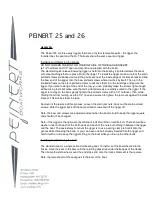
1-17
E
Rules when encountering
vessels
There are three main situations that you
may encounter with other vessels which
could lead to a collision unless the Steering
Rules are followed:
Meeting: you are approaching another
vessel head-on
Crossing: you are traveling across
another vessel’s path
Overtaking: you are passing or being
passed by another vessel
In the following illustration, your watercraft
is in the center. You should give the right-of-
way to any vessels shown in the white area
(you are the give-way vessel). Any vessels
in the shaded area must yield to you (they
are the give-way vessels). Both you and the
meeting vessel must alter course to avoid
each other.
Meeting
If you are meeting another power vessel
head on, and are close enough to run the risk
of collision, neither of you has the right-of-
way! Both of you should alter course to avoid
an accident. You should keep the other ves-
sel on your port (left) side. This rule does not
apply if both of you will clear one another if
you continue on your set course and speed.
Crossing
When two power-driven vessels are
crossing each other’s path close enough to
run the risk of collision, the vessel which has
the other on the starboard (right) side must
keep out of the way of the other. If the other
vessel is on your starboard (right) side, you
must keep out of its way; you are the give-
way vessel. If the other vessel is on your
port (left) side, remember that you should
maintain course and direction, provided the
other vessel gives you the right-of-way as it
should.
Summary of Contents for WaveRunner XL800
Page 2: ......
Page 8: ...1 3 E EJU00293 Important labels Label location ...
Page 9: ...1 4 E Warning labels 1 2 ...
Page 10: ...1 5 E 3 4 5 6 7 8 9 0 ...
Page 11: ...1 6 E Caution labels A B C D ...
Page 12: ...1 7 E Other labels F E G H I ...
Page 58: ...E MEMO ...
Page 128: ...E MEMO ...
Page 129: ...E 6 EJU00608 APPENDIX Limited warranty 6 1 YAMAHA EXTENDED SERVICE Y E S 6 3 Index 6 4 ...
















































